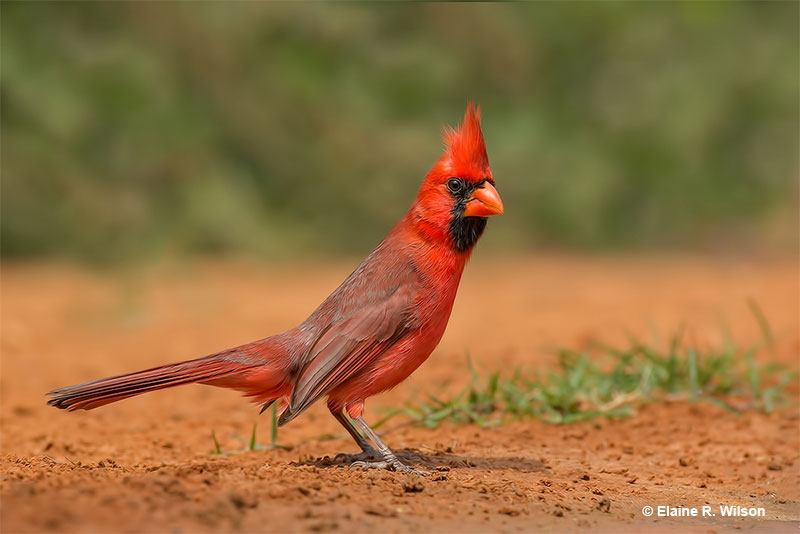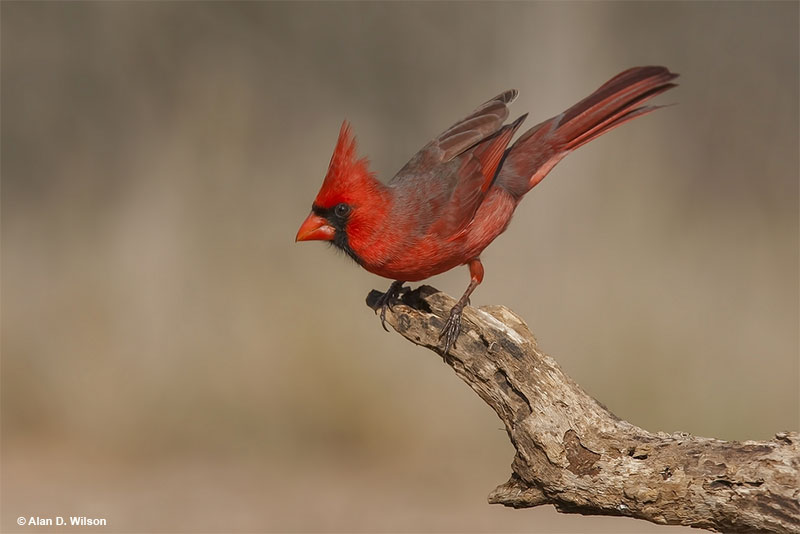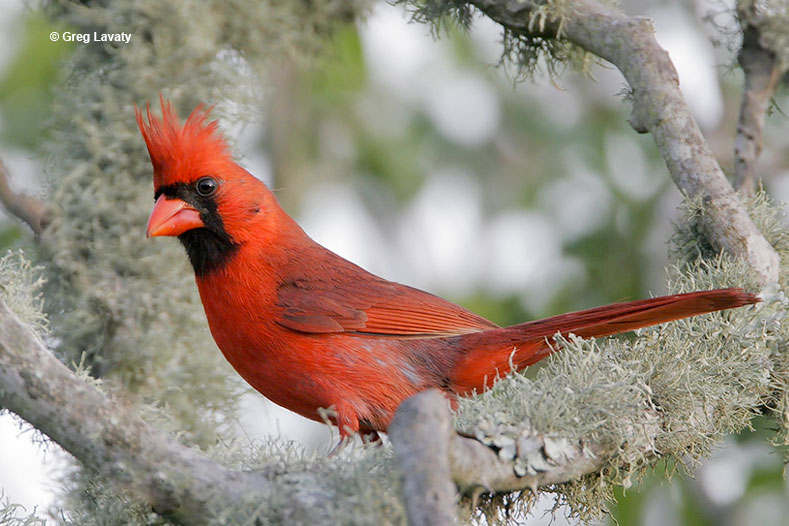
The Illinois State bird is the Northern Cardinal – an extremely well-known bird that is arguably the bird species that gets people into birdwatching!
These birds are relatively large songbirds with short, thick bills, prominent crests, and long tails. They usually sit with a hunched-over posture and point their tails straight down.
Illinois is a midwestern U.S. state whose terrain consists of wetlands, farmland, rolling hills, and forests. The capital of the state is Springfield. It’s a relatively large state with a population of 12.67 million people and a 57,918 sq mile size.
If you want to attract these birds to your yard, you’re in luck! Almost any bird feeder you put in your yard will attract these birds if you live in their range. However, they especially love sunflower seeds.
Leave undergrowth in your yard or around the edges to give Northen Cardinals optimal nesting sites.
On this page
History of Illinois State Bird
The Northern Cardinal (Scientific name: Cardinalis cardinalis) became a state bird of Illinois in 1929.
It was adopted as the state’s bird because the schoolchildren of Illinois voted for the Northern Cardinal to be their state bird in 1928. However, it took Congress about a year to officially name the Northern Cardinal the state bird of Illinois.
Although the Northern Cardinal is also the state bird of 6 other states, including Ohio, Indiana, Kentucky, West Virginia, Virginia, and North Carolina, the state of Illinois was the first state to claim the Northern Cardinal as its state bird. The other candidates were the bluebird, oriole, bobwhite, and meadowlark.
Northern Cardinals have an estimated breeding population of 130 million. The expansion of suburban and agricultural habitat over the last 200 years has been ideal for Northern Cardinals, which are abundant in central and eastern North America. It’s reported that their numbers have increased by an estimated 0.32% every year since the late 1960s.
Northern Cardinals inhabit dense shrubby areas such as overgrown fields, forest edges, hedgerows, marshy thickets, backyards, mesquite, ornamental landscaping, and regrowing forests.
Cardinals look for fairly high, conspicuous perches for singing and nest in dense foliage. The growth of suburbs and towns across eastern North America has helped the species expand their range northward.
Facts about The Northern Cardinal
- Northern Cardinal happens to be a state bird for 7 states: Illinois, Indiana, Kentucky, North Carolina, Ohio, Virginia and West Virginia.
- Northern Cardinals are usually the first bird to visit feeders in the morning and the last bird to visit in the evening. Ornithologists are still determining why, but it’s believed that they do this because there’s less competition. Additionally, males appear to be less bright in low light conditions, providing them some protection from natural predators.
- Occasionally, people see Yellow Cardinals! This is extremely rare and happens because of the lack of the typical red pigment in the plumage. Instead, orangish or yellow pigments replace the red color. The appearance is usually caused by a genetic variation called xanthochroism.
- Northern Cardinals are granivorous animals. Granivorous animals are those who have a diet that’s primarily seeds. Their cone-shaped, stout, and short beaks are designed to crack open the shells on nuts and hulls on seeds.
- When courting, affection between birds is expressed by the male feeding the female seeds. This method is known as “beak to beak.” To many, it looks like the birds are kissing!
- Northern cardinals are monogamous, and pairs have been known to stay together all year!
Identification
The Northern Cardinal is an extremely well-known bird that is arguably the species of bird that gets people into birdwatching!
These birds are relatively large songbirds with short, thick bills, prominent crests, and long tails. They usually sit with a hunched-over posture and point their tails straight down. Northern Cardinals are a little bit smaller than an American Robin.

Male and female cardinals look pretty similar, but there are some notable differences. Male cardinals are brilliant, bright red overall. Additionally, they have a black face immediately around their reddish bill.
Female Northern Cardinals are pale brown all over and tinges of warm red on their crest, tail, and wings. They also have a black face immediately around the reddish bill.
Northern Cardinals are 8.3 to 9.1 inches (21 to 23 centimeters) long, weigh 1.5 to 1.7 ounces (42 to 48 grams), and have a wingspan of 9.8 to 12.2 inches (25 to 31 centimeters).
Call
Both females and males sing. Their song involves a loud string of two-parted or clear down-slurred whistles. The song, more often than not, speeds up and ends in a slow trill. The songs typically last a couple of seconds.
Syllables can sound like the Northern Cardinal is singing birdie, birdie, birdie, or cheer, cheer, cheer. Male Northern Cardinals, in particular, can sing throughout the entire year, though they sing the most in the spring and the beginning of summer.
Scientists have found more than 15 different calls from this bird. However, the most common one is a loud, metallic chip. These birds make this call when defending their territory and warning any predators.
In addition, when one bird of a mated pair is about to feed the other, one of them often makes a softer “took” note.
Behavior
Northern Cardinals are most often seen foraging near or on the ground or hopping through low tree or shrub branches. They are looking for berries and grains. Northern Cardinals occasionally like insects, such as snails, spiders, grasshoppers, and beetles, but they do not depend on them.
Additionally, they often preen and sing from a tall branch on a shrub.
Their distinctive crests can be pointed and raised when they’re agitated to barely visible and lowered while resting.

If you’ve ever observed these birds before, you probably noticed that they’re typically in pairs. Seeing a pair most likely means it’s the breeding season for these birds. This is because, in the fall and winter, Northern Cardinals form relatively large flocks that can contain several dozen birds.
Related: Do cardinals mate for life?
During foraging, young Northern Cardinals will make way for adult birds, and females usually make way for the males. Cardinals can sometimes be seen foraging with other species, including White-throated Sparrows, Dark-eyed Juncos, Tufted Titmice, Pyrrhuloxias, and goldfinches.
They tend to look like they’re flying reluctantly and take short trips between thickets on their round, short wings.
Pairs sometimes stay together through the winter months, but around 20 percent of Northern Cardinal pairs split up before the next breeding season.
Which Other Birds Can You See In Illinois
While the state bird is widespread across the state, there are still lots of different bird species you can see in Illinois. Apart from countless songbirds, there are lots of owls, woodpeckers, ducks, and even hawks.
Here are the most common ones:
- Northern Cardinals
- American Robins
- Canada Geese
- House Sparrows
- American Goldfinches
- Mourning Doves
- Downy Woodpeckers
Read more: Most common birds of Illinois
Frequently Asked Questions
What is the state animal of Illinois?
Illinois state animal is the White-tailed Deer, which happens to be the state animal of many other states, such as Georgia, Mississippi, and Ohio.
What other state symbols does Illinois have?
Illinois has plenty of state symbols in place. The most noteworthy are the state flower (Violet), state amphibian (Eastern Tiger Salamander), and Illinois even has a state pie – Pumpkin pie!
Why did Illinois choose the Northern Cardinal?
Northern Cardinal was chosen as the state bird by Illinois schoolchildren in 1928. We can only speculate why they chose the Northern Cardinal, but their beautiful red feathers probably played a part.
Do cardinals leave Illinois in the winter?
Cardinals live in Illinois year-round; they do not typically migrate.

